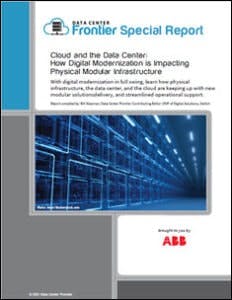How Digital Transformation is Impacting Physical Modular Infrastructure
2020 was an eye-opening moment for nearly everyone. Cloud and data center leaders raced to ensure that users had the digital tools they needed to succeed. The result? More modernization efforts, reliance on digital infrastructure, colocation deployments, hyperscale, and even cloud architecture. This launches our special report series on Cloud and the Data Center: How Digital Modernization is Impacting Physical Modular Infrastructure.
Get the full report.
Unlike digital booms in the past, something feels different today. A recent report indicates that the global data center market size has witnessed a significant boost since the outbreak of the COVID-19 pandemic across the globe. The demand for data centers has increased because of the reliance on Internet-related services aided by nationwide lockdowns imposed by governments worldwide.
The COVID-19 pandemic has dramatically increased internet traffic between 25% and 30% during the initial lockdown period (March-April) worldwide, which is 10X times than average growth (~3% per month). Cloud-based services have observed a spike as organizations, including government bodies, require transferring, storing, and securing confidential data and information.
When it comes to digital solutions, 2021 and beyond will be hitting the accelerator. Outside of the growth in data center and cloud services, the method by which these are being deployed is truly evolving. The rapidly evolving competitiveness in the global market and advanced technologies such as cloud computing and Big Data have made it simpler and cheaper for enterprises to shift their workload to self-contained data centers.
Organizations are looking at solutions that will make it easier for them to address the market and improve their speed to deployment. With these design considerations come challenges as well. How do you ensure reliability as well as efficiency during an era of unprecedented digital modernization? How do you ensure that things like latency don’t slow down your digital platform? Most of all, how can new, modular designs help data center and cloud providers become more secure, improve standardization, and create a far more scalable ecosystem?
This special report dives into some of the latest trends around:
- Cloud
- Data center solutions
- Digital modernization
- Where physical infrastructure is being impacted
Further, we’ll examine real-world modular solutions that help companies reduce their time to deployment while supporting the future of cloud, edge, and emerging data center solutions.
Introduction
Welcome to the digital era, where you are the digital citizen. Our reliance on new forms of communication, interaction, and doing business has evolved over the past decade. However, that evolution hit the accelerator over the past year.
In 2012, we crossed into the zettabyte era. That is, the amount of data in our digital ecosystem for the first time exceeded a zettabyte. Today, that number continues to increase, with estimates pointing to around 175 zettabytes by 2025.
At the heart of all this is your data center. However, there has been a fundamental shift in deploying technology solutions and where digital modernization impacts physical infrastructure. Too often, we look at modernization efforts as server upgrades and new pieces of software.
However, the digital evolution is happening on the data center and cloud infrastructure front.
The New Cloud and Data Center Balance
Before we dive in, it’s essential to very quickly understand the various types of data center models.
- Traditional/Enterprise Data Centers: These are your traditional facilities designed to support one customer or client. They’re often built at a corporate campus.
- Colocation: This is a multi-tenant data center provider. These data center models can range in size from just a few thousand square feet to campuses that are well over a million square feet. The largest colocation providers are known as hyperscale data centers.
- Cloud (Public): This defines sizeable public cloud services like AWS, Azure, and GCP. Public cloud providers will usually have their own data centers, often as large as the hyperscale providers in the colocation space. It’s important to note that public cloud providers do not exclusively build their own data centers. They will often partner with colocation and hyperscale colocation providers to extend their services.
- Edge: This class of data centers is designed to be smaller and often modular in architecture. Their purpose is to help bridge the connectivity gap, reduce latency, and facilitate the faster delivery of applications, data, and services closer to businesses, cities, users, and physical devices like cars, phones, and other IoT devices.
There has been a shift in how traditional data centers and hyperscale providers have impacted the industry. In a 2016 report, the Lawrence Berkeley National Laboratory estimated that if 80% of servers in small US data centers were moved over to hyperscale facilities, this would result in a 25% drop in energy use. If you look at the data center and hyperscale market today, you’d see that this is very much already underway. Per the graph below, you’ll see that traditional data centers are going away. They’re being replaced with more efficient, larger, and often modular hyperscale data centers.
Today, the world has around 600 hyperscale data centers, many of them mopping up services for small corporations or universities that would have previously had their servers. And, there are approximately 6,600+ colocation and wholesale data center facilities across North America, EMEA, Asia-Pacific, and Latin America.
There have been proven trends in repatriating workloads from cloud computing back to the data center. For the past two years, the AFCOM State of the Data Center report indicated a significant trend in how organizations view cloud solutions. Definitions are blurred as the cloud takes on a broader meaning where it’s not just public cloud solutions.
Per the latest report, nearly 60% report noticing a trend for organizations to move away from the public cloud and looking to colocation or private data centers. Last year, the majority of respondents also indicated this cloud repatriation trend.
It’s important to note that it is certainly not the end of cloud computing. Cloud computing isn’t going anywhere. So, what’s changed? And how are data centers creating a better cost equation?
Our understanding of cloud workloads, where specific resources should live, and how we can plan for the future are vital considerations. The fun part is that we see a better balance between the cloud and the data center.
The other key point is how we’re deploying these cloud and data center solutions. With digital modernization impacting digital infrastructure, it’s essential to explore how our physical components are affected. This means looking more closely at modular infrastructure, ensuring we leverage resources properly while improving ROI and a company’s speed-to-market.
How Digital Transformation is Impacting Physical Infrastructure
The design landscape of the traditional data center has genuinely shifted. Data centers’ architectural, mechanical and electrical schematics have typically been an open book looking at previous designs. Data center engineers were tasked with designing environments that could support business needs both now and in the future. There was a genuine drive to anticipate what requirements would be for the next 10 to 15 years.
Fast forward to those 10-15 years later, and we have a data center environment that is forced to work with cloud computing, big data, and vast user distribution.
As the world moves through the COVID-19 pandemic, organizations across industries are accelerating their digital transformations and looking toward technology to help them adapt to a new normal where disruption could be around every corner.
Modular construction methods have been evolving in data center projects for some time, but the impact of COVID-19 will undoubtedly put this at the forefront.
A recent report from Fortune Business Insights indicates that the global modular data center market size was $16.56 billion in 2019 and is projected to reach $65.55 billion by 2027.
Apart from cost savings, modular constructions benefit from reducing the number of people required onsite during the construction phase. Due to the COVID-19 pandemic, there is a fresh surge in the already brisk demand for online services, and more capacity is needed. Consider this from a recent Allied Market Research report:
The spread of COVID-19 has considerably augmented the data traffic. In addition, the surge in storage volume requirement is due to the pandemic driven by the proliferation of emerging technologies such as artificial intelligence (AI), big data, and the Internet of things (IoT). This will continue to drive modular data center investments across the globe.
This shift into a more modular design is a direct result of digital modernization efforts impacting physical infrastructure.
When looking at emerging solutions like edge, cloud computing, and new designs around colocation and hyperscale ecosystems, the modular approach to data centers addresses many of the same concerns and offers similar benefits. A modular data center also factors into both sides of the traditional build versus buy equation. When deciding to build, the modular data center approach and products have tremendous benefits for making the ownership of a data center very attractive. Many providers offer a modular data center approach for their customers, taking advantage of modular while not committing the capital.
A modular solution takes the best ideas for design, reliability, and efficiency and packages everything into a prefabricated, repeatable, and operationally optimized module. This translates to a truly agile data center environment that is capable of scale. As the organization adopts more cloud-based distributed technologies, a modular architecture can immediately support additional workload and business demands.
Download the full report, “Cloud and the Data Center: How Digital Modernization is Impacting Physical Modular Infrastructure,” courtesy of ABB to learn more about how physical infrastructure, the data center, and the cloud are keeping up with new modular solutions delivery, and streamlined operational support. In our next article, we’ll go beyond the cloud and see modular solutions are also impacting future designs around 5G, edge, IoT, and emerging cloud solutions.
About the Author




